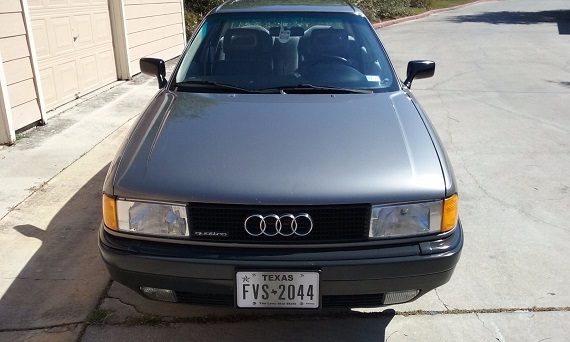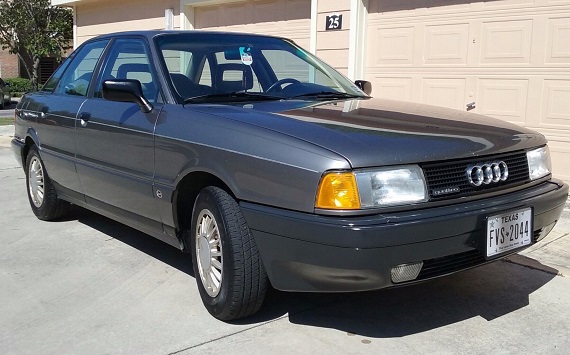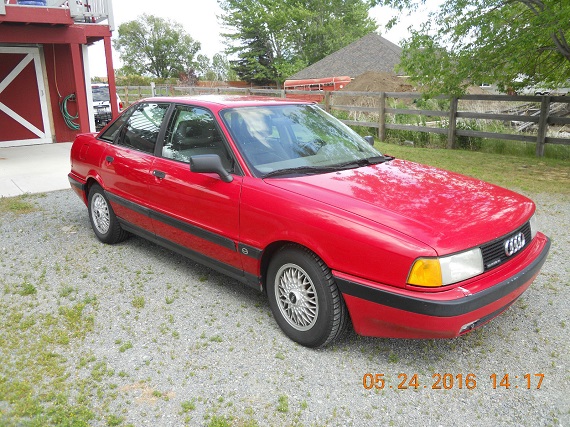While the move from the B2 to B3 chassis brought many changes to the small Audi lineup, it was also very much a case of ‘meet the new boss, same as the old boss’. Some of the features of the 4000 were gone; you could no longer opt to lock the center differential, for example, since the manual locker had been replaced by a more sophisticated Torsen unit. You could still opt to engage a rear differential lock, but electronics overrode that at 15 m.p.h.. That change was indicative of movement in the marketplace and where the B3 was aimed – slightly more upscale from the B2. Interior quality was greater, and production was broken into two categories as it had been in Europe. Selecting the top-range 90 quattro got you nicer BBS wheels, color matched bumpers and mirrors, a sportier raised spoiler, a better leather interior and wood trim. The downscale 80 would channel more of the outgoing 4000, with savory Serret Velour and a more plastic-heavy interior. They even opted to keep the same Ronal R8 wheels as the old model early on, and the subtle rear spoiler was a near copy of the B2. The more basic 80 was closer in performance to the 4000, too – the luxury and safety items of the B3 meant more weight, and the 90 tipped the scales at nearly 3,000 lbs. Mechanically identical, the 80 quattro was about a hundred pounds lighter and anyone who has driven 80s normally aspirated Audis knows that 100 lbs. makes a difference in performance. Motivation for both was the same NG-code inline-5 that was seen in the last Coupe GT Special Build models, meaning 130 horsepower and 140 lb.ft of torque – smoothly adequate, but certainly never overwhelming. As with the 1988 5000S I looked at the other day, these models came to market at a time of crisis for Audi, and consequently few were sold. Audi’s best year of sales for the B3 quattro twins was 1988 when just over 3,000 were sold – only a handful more than the outgoing 1987 4000CS quattro, and rare for a new model. This Stone Gray Metallic example is one of the few that come to market and looks like one of the better ones we’ve seen:
Tag: Torsen
Finding a modified B5 generation Audi S4 isn’t exactly a hard thing. Finding a good one, though, arguably is. The B5 generation brought Audi into a new scene of tunability and off the bat was a hugely popular platform. However, from salvage titles, high mileage, dubious modifications and poor condition to the big one – neglected maintenance – sorting through the plethora of “Stage X” S4s out there can leave one believing there just aren’t many top-tier examples left. But then you set your eyes on this retina-searing Imola Yellow sedan, and your faith in the platform is restored. With 44,650 miles on the clock, it’s one of the lower mileage B5s I’ve seen recently, but what really sets it apart besides the color are the RS4 body modifications. That, and 650 wheel horsepower:
CLICK FOR DETAILS: 2000 Audi S4 on eBay
2 CommentsFor U.S. customers, 1992 rather quietly signaled the end of an era for fans of the small chassis. Starting in the early 1980s, Audi had offered their offbeat 5-cylinder motor in models like the 4000 5+5 and Coupe models, but it was really the rally success of the Quattro that put the 5-pot on the map. But the turbocharged variant was quiet expensive, so fans of Audi’s WRC campaign rejoiced in 1984 when the all-wheel drive platform became much more affordable in 4000 quattro form. In Europe, there were several variants and power plants available in 80 and 90 form, but U.S. customers only got the relatively high-spec 4000S/CS quattro. Audi revised the model lineup with the B3 model run, introducing the lower-spec 80 and the more luxurious (and later, more powerful) 90. When the 90 went to the DOHC 7A 20V inline-5, the 80 remained with the 10V 2.3 liter NG which had first appeared in the Special Build Coupe GT model. Though not hugely powerful and feeling slightly overwhelmed by the 80 quattro’s mass, it was a very smooth and fun to drive package capable of huge odometer readings. The package remained available until 1992, when life of the 80 ended in the U.S. as it was not upgraded to B4 specification. As with all Audis from the period, it sold in small numbers: Audi reported only 640 sold in 1992, with not many more sold in the years before it. As the book closed on the inline-5 with a whimper rather than a bang, it’s relatively infrequent to spot one of these late 80s:









